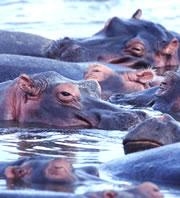 The secretions appear on the hippos' backs, faces and behind their ears.© Photodisc
The secretions appear on the hippos' backs, faces and behind their ears.© PhotodiscThe colourful secrets of hippopotamus sweat have been unlocked. Researchers have identified the chemicals responsible for the ancient myth that the beasts sweat blood.
In reality, hippos' secretions are neither blood nor precisely sweat, but a mixture of pigments that function as both sunscreen and antibiotic, as well as keeping the animals cool, say Kimiko Hashimoto of Kyoto Pharmaceutical University, Japan, and colleagues.
The scarlet secretion is a familiar sight to anyone who has come face to face with a hippo (Hippopotamus amphibius). "It's all over their back, face and behind their ears," says Craig White, a zookeeper at Whipsnade Wild Animal Park in Britain. "It really does look like blood is pouring down them."
The hippos tend to produce more of the substance when they are on dry land rather than swimming in rivers or lakes, says White, bolstering the idea that the secretions are akin to sweat. But other experts have suggested that it functions as waterproofing; adults can remain submerged for more than five minutes at a time.
Sweaty work
Hashimoto's team used gauze swabs to collect the fluid from the faces and backs of two hippos, Satsuki, a female, and Jiro, a male, living at Ueno Zoological Garden in Tokyo.
Such an undertaking might sound fairly hair-raising, given hippos' fiercely aggressive reputation. But the beasts can be docile in the right hands, says John Davis of Riverbanks Zoo and Garden in Columbia, South Carolina, an expert on handling zoo animals. "In the wild it would be very tricky, but if anyone wanted that stuff off a hippo in captivity it would be highly achievable."
Having taken the samples, the Japanese team analysed their chemical make-up and found two pigments, one red and one orange, which they christened hipposudoric acid and norhipposudoric acid, respectively. It is these compounds that give hippos their ruddy appearance, the group reports in this week's issue of Nature1.
Having isolated the chemicals, the researchers set about testing the theory that they function both as sunscreen and antibiotic . After examining how much of the Sun's spectrum is absorbed by the pigments, they conclude that the compound would indeed shield hippos from harmful ultraviolet rays.
And the red pigment also restricts the growth of the disease-causing Pseudomonas aeruginosa and Klebsiella pneumoniae, showing that the mixture may protect hippos from bacteria.
Such a dual function would be useful to the huge beasts, which live in central Africa, largely in the Nile Valley. They spend a lot of time in direct sunlight, and frequent fierce clashes with rival hippos leave them scarred and potentially vulnerable to infection.
In isolation, the newly discovered compounds are very unstable, Hashimoto's team says. But hippos can retain their blood-red hue for several hours before losing their lustre. The researchers suspect that mucus secreted with the pigments may delay their discolouration.
